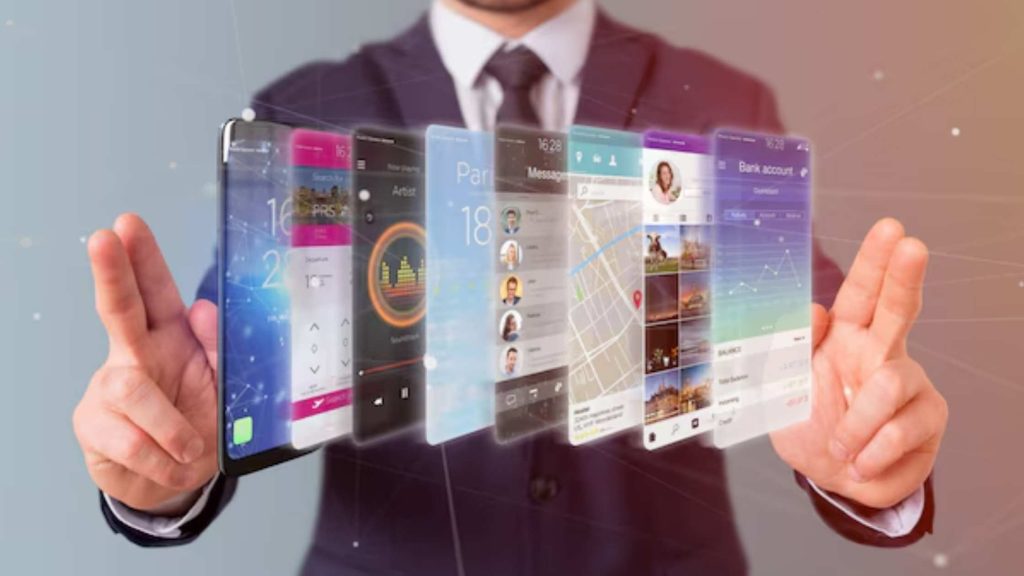Introduction
Mobile marketing automation is changing the way in which brands communicate with their audience. In the cutthroat digital world, generic promotions no longer make the grade: consumers want personal, timely, and relevant ad experiences that meet their needs and preferences.
Enter mobile marketing automation. Data, automation, and personalization can be powerful tools for brands to reach customers, develop loyalty, and drive retention. Using automated push and in-app messages, personalization, and dynamic content, you can design a user journey that’s both relevant and frictionless, making it easy to form strong, long-lasting connections at scale.
Mobile marketing automation is the act of using special software or methods to assist in personalizing mass marketing on mobile. Whether embracing new users or re-engaging dormant ones, automation empowers businesses to say the right thing at the right time to the right person.
This article will take a look at how to get the most out of personalization on mobile, using marketing automation. We will also learn about the hottest mobile marketing automation trends, the most desired features when evaluating platforms, and takeaways to help improve your mobile strategy.
What is Mobile Marketing Automation?
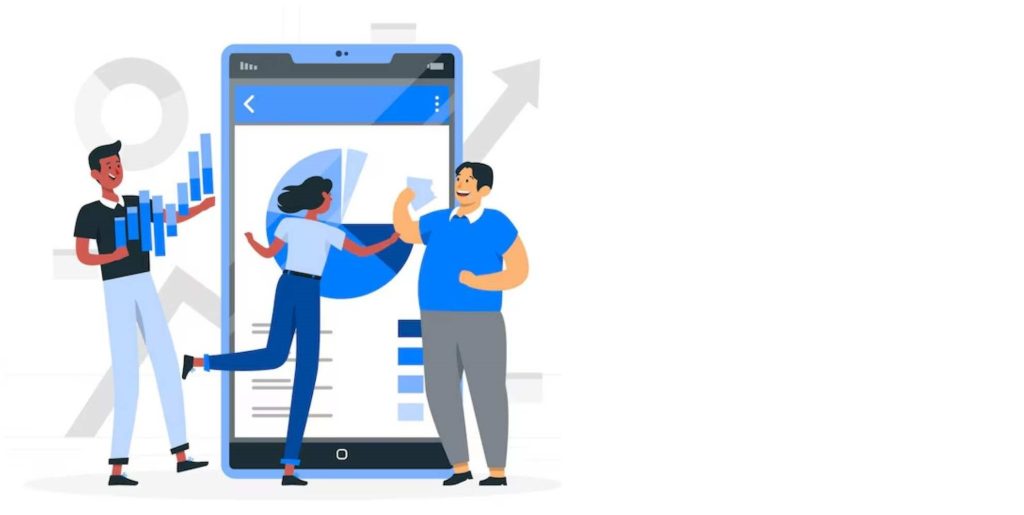
Definition: Mobile marketing automation is the technology that enables the automation of marketing processes and user experience. It enables companies to make their message heard by the right people, at the right time, through an automated message triggering in real-time.
In other words, automated mobile marketing breaks down barriers and enables companies to go beyond volume play. Instead of a one-size-fits-all message, these updates allow marketers to create a unique experience by displaying a message with different content and calls-to-action based on a user’s in-app behavior, preferences, and lifecycle stage. This results in healthier relationships, in turn, increased engagement, loyalty, and retention.
What can mobile marketing automation do?

With new mobile campaign automation software, you can now automate all kinds of mobile marketing tasks across multiple mobile channels, such as:
- Push notifications: Act in real time, specifying the target and impact on users and mobile devices.
- In-app messages: Show unique content or offers while someone is in your app to enhance the user experience.
- SMS campaigns: Contact users with the latest deals, transactional information, or service messages through text messages.
- Mobile-Friendly Email Campaigns: Send app-like email campaigns that echo your app and mobile web strategy.
- Tailored product recommendations: Highlight products or content that are relevant to the user’s interests or previous actions.
- In-app real-time personalization: Update content and features within apps instantly, targeting your app’s display and the content on it directly to specific user profiles and actions.
How It Works
Your mobile marketing automation software integrates your mobile app, customer relationship management (CRM) system, analytics solutions, and other marketing tools.

It collects and analyzes rich user data, including:
- App usage patterns
- Purchase history
- Location data
- Session frequency and duration
- Previous campaign involvement
- Demographic information
- Customer lifecycle stage
With this data, marketers can dynamically segment users, send adaptive messages in real-time, and refine campaigns on the fly through performance data.
For example:
- A user repeatedly visiting products of a certain category can be served targeted recommendations.
- Automate the enrollment of a first-time buyer to a welcome or loyalty program.
- A churn-risk user can receive a win-back offer.
How to Scale Personalization
“At its heart, mobile marketing automation is the ability to personalize at scale. While one-to-one marketing would be ideal, obviously it’s unrealistic for anyone to write a script that sends thousands (or millions) of 100% personalized messages to our users. This is made possible by automation, which allows you to deliver highly relevant experiences to every individual at scale.

This is especially important in a mobile-first world. Given that customers engage across apps, mobile web, SMS, and email, providing a unified messaging experience across these touchpoints is critical in establishing trust and fostering long-term relationships with customers.
And in the end, MMA is not just about saving time, but about making marketing more effective. By providing more personalized, timely, and meaningful experiences, businesses can dramatically drive engagement, increase retention, and raise lifetime customer value.
In the chapters that follow, we’ll explain how, exactly, this is taking place and dissect some of the new mobile marketing technology trends that are changing the shape of mobile marketing as we know it.
Also Read: Blockchain Data Entry Services
The Impact of Mobile Marketing Automation on Personalization
Today’s users expect brands to know and respect their preferences, and give them experiences that feel relevant and meaningful, and they want it in a second. This is where mobile advertising automation comes in. With the use of real-time data, intelligent segmentation, and dynamic messaging, it is possible to add personalization that mobilizes the customer.
Here’s how it works:
1. Behavioral Segmentation
And when it comes to behavior-based marketing, segmentation is one of its superpowers.

Rather than build static lists, automation solutions look at:
- In-app behaviors
- Purchase history
- Browsing patterns
- Time since last engagement
- Interaction with individual features
- Frequency and length of appointments
These learnings empower marketers to develop extremely targeted segments, so users receive messages that are truly tailored based on their interests and stage in life. For example:
- A user with frequent interactions in a specific product category can also be recommended.
- VIP segments exist, and you can put high-value customers in them, and they can get special promotions.
- Dormant users can also be targeted for re-engagement campaigns.
2. Real-Time Triggered Messaging
MMA takes personalization beyond segmentation through real-time transactional messaging. Which is to say, the communications are issued automatically based on user activity or contextual cues, not according to some generic timeframe.
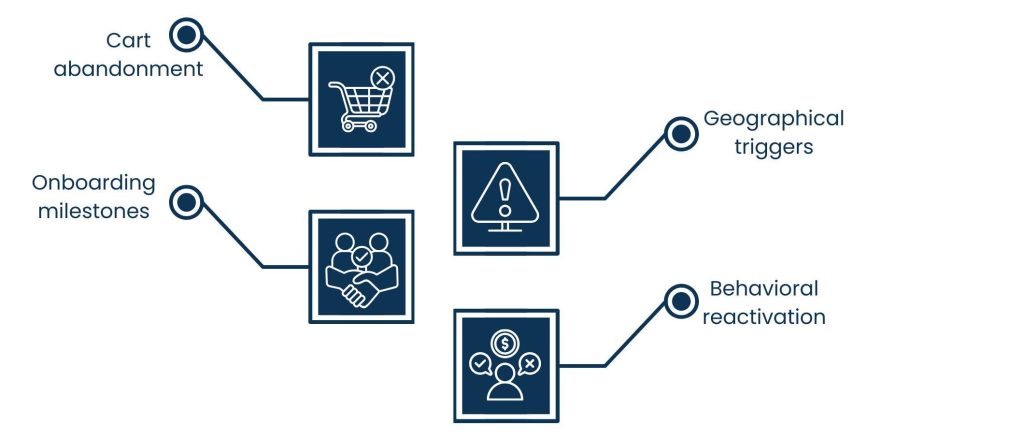
Examples include:
- Cart abandonment: When a user adds item(s) to a shopping cart but fails to complete the transaction, a push notification or email reminder can be automatically sent to him or her.
- Onboarding milestones: You can congratulate the user or encourage them to take the next action after the user completes important onboarding steps.
- Geographical triggers: When a new user arrives in a particular geofence, they can receive an offer.
- Behavioral reactivation: Encourage the reengagement of those who have stopped using a key feature with tips or rewards.
With the right timing, brands can build experiences that feel natural and useful, rather than invasive.
3. Dynamic Personalization of Contextual Content
Today’s automation solutions support extreme personalization of message content, not just for when content is delivered and to whom.

Dynamic content blocks that allow marketers to personalize their:
- User names
- Recent-Behavior-Based Product Recommendations
- Personalized content blocks
- Photos corresponding to the user’s interest
- Custom CTAs
For example, a push notification might say:
“Hi Alex, you liked the running shoes that are back in stock, enjoy 10% off today!”
Or an in-app banner could read:
“You loved [previous purchase], so we found more styles we think you’ll love.”
This amount of personalization results in real relevance, and with it, a better chance of your users interacting and converting.
4. Multichannel Personalization

With mobile marketing automation, brands can create consistent, personalized experiences across all mobile channels:
- Push notifications
- In-app messages
- SMS
- Mobile-optimized email
Users don’t interact with your brand in isolation, they fluidly move across apps, SMS, and email. Mobile marketing automation ensures that you have an experience that is uniform and consistent throughout these touchpoints, making your brand relationship more robust and increasing loyalty.
In the next section, we’ll see how these experiences at a personal level eventually result in happier customers. By understanding this is true, we can start to imagine how targeting leads to more retention, an essential result of a successful mobile advertising automation strategy.
Mobile Marketing Automation and The Evolution of User Retention
In a world that is mobile-first today, the retention of users is one of the largest contributing factors to long-term business success. The cost to get a new user is expensive, but the lifetime value (LTV) of keeping users engaged and loyal is much higher. This is where mobile communication automation is an indispensable piece to your retention strategy.
Through personalized, relevant, and timely experiences during the customer journey, mobile marketing automation solutions prevent churn, build brand loyalty, which in turn, transform users into happy, loyal customers downstream. So, how exactly does it work?
1. Onboarding Campaigns for Welcoming New Users
The first days after a user downloads your app are crucial. Most app uninstalls occur in the first week, based on studies. Mobile messaging automation enables you to build automated onboarding journeys that lead new users through a process of demonstrating value and driving key behaviors.

For example:
- A first push notification can welcome users and showcase the app’s best features.
- In-app tutorials may be interactive in real time based on user input.
- Automated emails can contain useful advice or a monetary reward so that you can retain customers.
It will drastically improve your 1st week & 1st month retention. Customized onboarding helps new users quickly get the value of the app.
2. Loyalty Driven Rewarding and Incentivizing of Deeper Engagement at Scale
Mobile marketing automation helps brands track user activity and reward loyalty in real-time using mobile.

Loyalty programs can easily be added to the mobile experience:
- Access to special benefits at varying VIP levels
- Automatic reward messages when users reach new milestones
- Special offers for power users or heavy buyers
When brands acknowledge and reward their best customers, they create more emotional connections, which in turn drive increased engagement and repeat purchases over time.
3. Re-Engaging Dormant Users
Not every user will always be as active; that’s human nature, but mobile marketing automation provides some pretty potent weapons to win your users back.
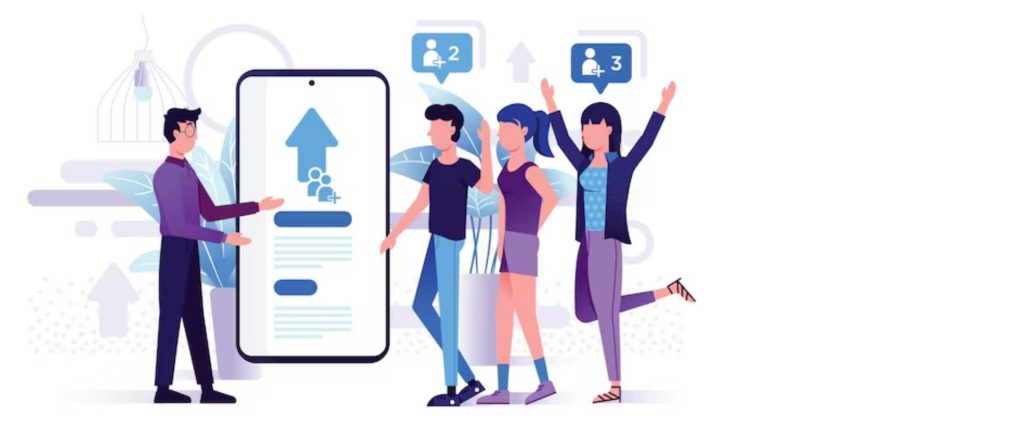
Plan automated win-back campaigns according to user inactivity:
- Push alerts with customized offerings to come back.
- Messages reminding of value/new features in the app.
- Time-bound promotions using SMS.
The key is personalization. The messages themselves are not only personalized to the user’s past behavior and preferences, but to the application, making re-engagement feel relevant rather than spammy.
Automation of these reactivation campaigns leads to an uplift in returning users for many of our brands.
4. Predictive Churn Reduction
The most modern automated mobile customer engagement tools, meanwhile, are going to use AI & ML more and more to determine churn risk. From the investigation into behavioural signals (like less frequent sessions, less use of some features, or abandoned carts), automation tools reveal who is predisposed to disengagement.

After being flagged, these risky users can be automatically targeted with retention-oriented messaging:
- Custom deals, promotions, or discounts.
- You’re invited to try new features.
- Reminders of loyalty benefits.
This proactive behavior helps decrease churn before it occurs, leading to healthier retention rates overall.
5. Building Uniform Multichannel Experiences

Retention isn’t one thing; it’s about an ongoing relationship. Mobile marketing automation can help brands deliver the same unique and personalized experience across all of their mobile touchpoints:
- Push notifications
- In-app messaging
- SMS
- Mobile-optimized email
When they have continuity and coordination of messaging across these touchpoints, they trust us, and that trust will keep them coming back, keep them engaged over time.
Now let us delve into upcoming Mobile Marketing Automation trends and how they are going to have a profound impact on the mobile engagement and retention space.
Mobile Marketing Automation Trends
With the increasing need for mobile and smarter, more personalized experiences. In order to satisfy these expectations, brands need to be in touch with trends of Mobile Marketing Automation; make adjustments to apply new methodologies and technologies that will help support the engagement and retention that your business relies on.
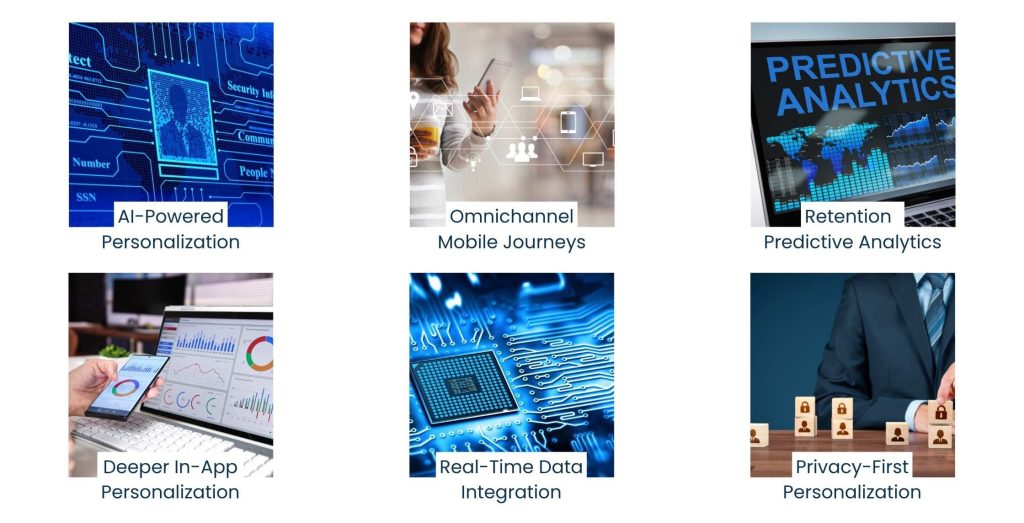
Here are some of the key trends that are defining the future of mobile marketing automation:
1. AI-Powered Personalization
One of the biggest ones in Mobile Marketing Automation is how artificial intelligence (and machine learning) are making personalization even more personalized.
Artificial intelligence (AI)-based automation platforms process huge data volumes to:
- Predict optimal message timing
- Recommend personalized content
- Anticipate user needs
- Identify churn risk
This is way beyond rule-based campaigning. AI makes it possible to deliver dynamic, 1:1 personalization at scale, meaning all users are engaged with messages that are uniquely personalized for their behavior and preferences.
For instance, such an AI-powered Mobile Marketing software could be able to notice that one user tends to prefer product recommendations in the evening and would rather receive an SMS than a push notification, and automatically tweak its messaging strategy accordingly in real-time.
2. Omnichannel Mobile Journeys
Mobile users engage with brands through various channels: apps, mobile web, SMS, email, social media, and many others. One key theme is the shift from channel-specific blasts to connected omnichannel experiences.
Today’s mobile marketing automation platforms facilitate campaigns to be integrated and work together:
- Push notifications
- In-app messages
- SMS
- Mobile-optimized emails
- Social messaging
The result is that users receive the same consistent, personalized experience across channels, channels are more satisfying, and as a result, users are more loyal.
3. Retention Predictive Analytics
With competition on the rise, brands are leaning increasingly on predictive analytics to feed retention. AI models can now forecast:
- Churn risk
- Lifetime value (LTV)
- Propensity to purchase
- Propensity to use certain functionalities
And, with a full suite of marketing automation tools at their disposal, once marketers receive such insights, they can automate campaigns to engage proactively, preserving retention, driving more revenue, and lowering marketing costs.
For instance, users marked as likely to churn could automatically get a personalized motivator to remain engaged, before they uninstall or disengage.
4. Deeper In-App Personalization
Another is richer in-app personalization, not just in the form of push notifications.
How brands deliver dynamic personalization with Mobile Marketing Automation:
- App home screens
- Product recommendations
- Content feeds
- Navigation flows
- Interactive features
That means each user will have an in-app experience that feels personally addressed to them, resulting in better engagement, more frequent sessions, and increased user retention.
5. Real-Time Data Integration
Real-time data integration is beginning to look like a must-have. The latest generation of mobile marketing automation software integrates with your CRM, product database, analytics tools, and data warehouses, allowing marketers to respond in real-time to user behaviour.
For example:
- Certain in-app actions, like referring friends or making an offline purchase, can trigger an instant thank-you message to the user in the app.
- Updated messaging across different channels in real-time based on a change in loyalty status.
- Real-time immediacy contributes to personalization and newfound consistent experiences for customers.
6. Privacy-First Personalization
Finally, personalization will become ‘privacy-first,’ as more brands are forced to accommodate privacy regulations (like GDPR) and operating systems make their products more private by default (like Apple with iOS).
- Transparent data collection
- Consent-driven messaging
- Respecting user preferences
Current trends in mobile marketing automation strike the right tone between personalization and trust so that you are showing your users they are valued, and not, well, violated.
Also Read: Crypto Community Management
The ROI of Mobile Marketing Automation
Mobile Marketing Automation is one of the smartest investments a business can make towards long-term profitability. Unlike short-term acquisition activity, automation is all about building more meaningful relationships with the users you already have — and that compounds over time.
Best of all, good messaging automation leads to better retention. Brands that provide personalized content, at the right place and the right time – in a user’s lifecycle – will keep visitors interested for longer. Increased retention results in higher lifetime customer value (LTV), as users who love your app spend more, purchase more frequently, and become advocates of your product.
Retention is also cheaper than acquisition. The higher your LTV, the more you can spend to acquire new users, or the greater margin you can enjoy. In a nutshell, the better your retention, the more efficient your other marketing funnels are.
Apart from keeping users, mobile marketing automation also boosts engagement and revenue on mobile. Suggestive product recommendations, dynamic promotions, and other timely re-engagement messages lead to higher conversion rates and get more casual users to become paying customers.
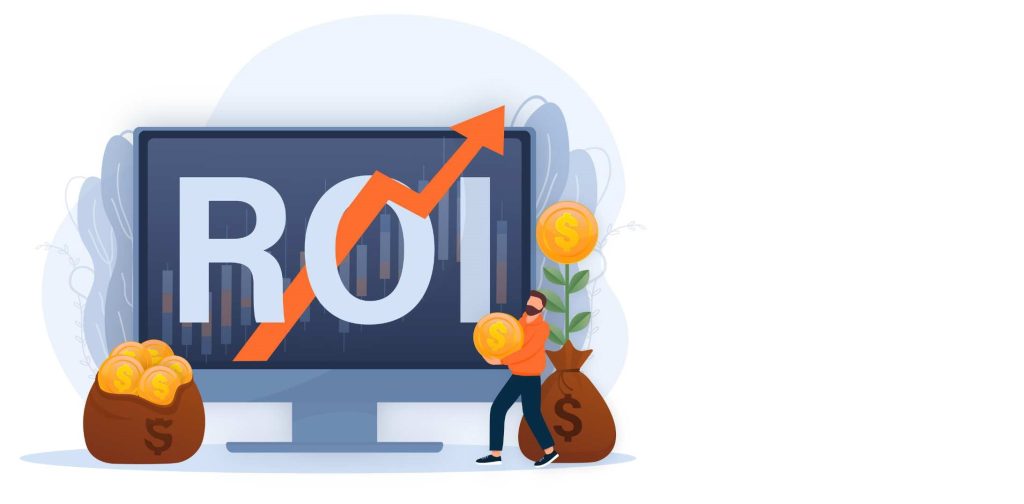
After automation is rolled out, many businesses are realizing double-digit lifts in crucial performance metrics:
- 20-30% increases in retention rates.
- 15-25% growth in average revenue per user (ARPU).
- 10-20% improvements in purchase frequency.
And because so much of the process is automated, these gains scale efficiently, without needing to make proportionally greater marketing investments.
In other words, Mobile Marketing Automation more than pays for itself. It increases customer loyalty, drives revenue, and enhances marketing efficiency, which is a worthwhile investment for any brand that has a mobile presence.
Conclusion
Mobile marketing automation is indeed no longer a nice-to-have; it’s a must-have for any brand looking to develop a long-term, two-way relationship with their mobile audiences. Using automation to provide personalized, on-the-fly experiences enables businesses to greatly enhance engagement, retention, and customer LTV.
With mobile behavior continuing to change at a rapid pace, remaining competitive means consistently tweaking your automation strategy. The newest trends, ranging from personalization based on AI to predictive retention tools, are allowing marketers to forge stronger connections with their audience.
Looking at the best Mobile Marketing Automation tools is critical. Leverage the right technology and you can choreograph omnichannel journeys, personalize at scale, and deliver measurable business results. But it doesn’t end there, success doesn’t stop once you’ve implemented your CRO strategy, consistent auditing and optimization are crucial in ensuring that your business reflects user expectations and the market landscape.
For those companies prepared to take their mobile marketing to the next level, experience counts for something. Teams such as ours at Tasks Expert can assist you in reviewing your EMM strategy, adopting best practices, and getting the most out of Mobile Marketing Automation, so that your campaigns deliver the results your business needs.
About Us
Tasks Expert offers top-tier virtual assistant services from highly skilled professionals based in India. Our VAs handle a wide range of tasks, from part time personal assistant to specialized services like remote it support services, professional bookkeeping service etc. Furthermore, it helps businesses worldwide streamline operations and boost productivity.
Ready to elevate your business? Book a Call and let Tasks Expert take care of the rest.





